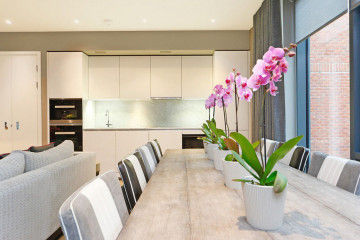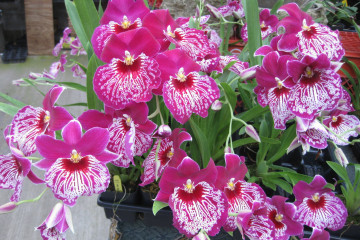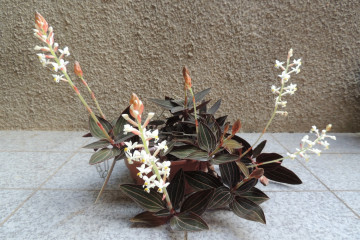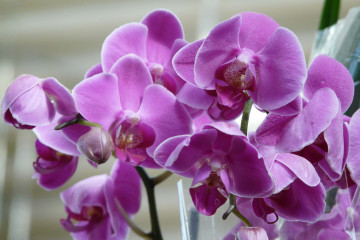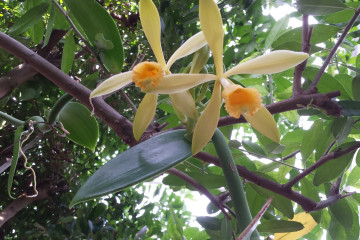Dendrobium orchid: options for care and reproduction at home
Content:
Orchids are known for being graceful, elegant plants. Dendrobium Orchid is quite consistent with these ideas. Her luxurious flowers are a feast for the eyes. The plant is not too demanding to care for, which increases its attractiveness for florists.
Main types
Today, there are many different types of this orchid. The classic color of the Dendrobium flower is white and purple, yellowish and reddish tones are also common. Some varieties have flowers of a mix color, differing at the edges and in the center.
Initially, Dendrobium lived on trees or rocks. Numerous aerial roots serve to fix it, which draw moisture and nutrients from the air.
In total, about 1500 species of Dendrobium orchids are known. They have stems, called pseudobulbs, on which oval leathery leaves about 10 cm long alternate.When the growing season comes to an end, the plant sheds leaves, in healthy individuals, shoots grow again and again.
Pseudobulbs take different forms depending on the type of orchid. They can be tubular, fusiform, or clavate. The length varies greatly: from a few centimeters to 1 m.
Numerous hybrid varieties are descended from Dendrobium nobile and Dendrobium phalaenopsis. Distinguishing them based on the arrangement of the colors is easy. Dendrobium nobile has flowers that grow from the edges of the stems of the previous year, if they form only at the tip of the shoot, this is a sign of Dendrobium aphalaenopsis.
Dendrobium Nobile
The second term "nobile" after Dendrobium is translated as "noble". It is a large plant with straight, fleshy tree-like stems. The oblong leathery leaves are arranged in two rows.
On last year's leafless shoots, short peduncles are formed, consisting of 2-3 flowers, containing ovoid petals, and sepals elongated in length, having a whitish color at the base, lilac or pink at the edges. The flower sponge, covered with fine hairs, has a dark purple spot at the bottom. The flowering period is January-May.
King's
Royal Dendrobium is distinguished by stiff, conical at the top and cylindrical in the rest of the shoots up to 30 cm long. The whitish bases of the leaves tightly cover the stem.
The low apical flower tip is assembled from small fragrant flowers ranging in color from white to bright red. The flower sponge is three-lobed; sepals grow together with lateral surfaces. February is the month of the appearance of the first flowers, which last up to 3-4 weeks.
Berry Oda
This orchid is a hybrid of Dendrobium king. When blooming, it spreads a pleasant vanilla aroma.
Differs in a long flowering period, if the plant has good conditions: from May to December.
Hibiki
This is a miniature hybrid variety of Dendrobium, up to 15 cm in height for a mature plant. The main distinguishing features are bright flowers of double color: purple and orange.To start flowering, a pseudobulb 3 cm in size is enough, the buds last over 30 days. The resulting inflorescences contain up to 8 flowers.
The shoots are shortened, have a pinkish color, the leaves are dark green, dense. Blooms in March-April, the active period lasts up to five months.
Dendrobium Phalaenopsis
A large species of orchid, the stems are long, fleshy. Leaves and flowers are located at the end of the stems. Large flowers reach a size of 3-8 cm, from 5 to 40 flowers are collected in inflorescences with a color from white to pale pink, dark red and even crimson.
Inflorescences retain their freshness for a long time, which makes them popular among florists when creating bouquets.
Dendrobium chrysotoxum
An orchid with yellow flowers and an intense honey scent. It has rather large flowers, collected in inflorescences of 10-15 pieces. Chrysotoxum's leaves are narrow and long, up to 10 cm.
Dendrobium trantuanii
Trantuniai grows naturally in the Vietnamese jungle. It is notable for its flattened stems, which give the plant an original look.
Long-lasting, large pale purple flowers are located on separate pedicels.
Dendrobium Moniliforme
Moniliform is a Japanese stone orchid. Blooms in late winter or early spring, possibly secondary flowering in the last summer month. The inflorescence has 1-2 fragrant flowers, there may be several of them on one stem.
The color is white, cream, yellow, green or pink. The pedicel is short, the petals are elongated.
Indoor orchid care
Those who start the Dendrobium orchid note that caring for it at home is much easier than for other varieties of this plant. Orchids come from tropical and subtropical Asia, where they grow epiphytically, that is, they use other trees or stones as support. These very specific living conditions determine the care requirements.
Watering
The aerial roots of Dendrobium orchids should not be watered, but irrigated by immersion. This procedure is repeated weekly.
Basic irrigation rules:
- Dip the root ball in water once a week;
- The substrate must not be too dry before re-immersion;
- Water is taken at room temperature, with a low calcium content, ideally without it at all. Hard water damages plants;
- After immersing the pot in water, you need to wait until air bubbles rise to the surface of the water;
- Rainwater is ideal for watering and spraying orchids;
- The humidity in the room must be at least 50%, it must be checked periodically. If the moisture readings are low, the orchid needs to be sprayed;
- If necessary, to feed the plant, fertilizers are dissolved in water. You should never use excessive amounts of them; underfeeding is better than overfeeding. It is recommended to use special fertilizers for orchids available on the market;
- Top dressing is done during the growing season, in summer.
Room temperature
To keep the Dendrobium orchid healthy, home care involves maintaining the correct temperature. The plant thrives at temperatures between + 16 ° C and + 23 ° C. If the room is too hot, it can lead to problems. In winter, Dendrobium prefers temperatures between + 16 ° C and + 18 ° C. Colds below + 10 ° C should be avoided.
Lighting
This type of orchid belongs to the light-loving, but the shining midday sun can lead to unsightly burns on the leaves. At home, they are under the canopy of host plants in the dense jungle, therefore, they are protected from the sun.
If the plant is placed on an open south window, it is better to use a protective curtain that creates diffused light. In winter, it is necessary to use additional lighting, for example, fluorescent lamps.
The soil
Regular indoor plant soil is not suitable for orchids. For them, it is important to use a special soil, which is a plant substrate consisting of bast, charcoal, pieces of bark, peat and foam flakes. Many florists prepare it themselves. Before backfilling the substrate, a drainage layer of small pebbles or brick chips is placed on the bottom of the pot. The surface of the soil is covered with bark.
Bloom
The flowering time of an orchid depends on the species. This usually happens in the spring, summer, or after resting in winter. During this period, it is necessary to ensure regular feeding and watering. During rest, on the contrary, the irrigation should be reduced and the temperature should not be higher than + 18 ° C.
Reasons for the lack of flowering
The lack of flowering is mainly observed if the plant is not properly taken care of. Only in some cases are various pests interfering with this.
Possible reasons:
- Lack of coolness during the rest period. If the temperature remains high, then instead of flowers, babies will form on the pseudobulbs. A difference between day and night temperatures up to 5-7 ° C has a good effect on the plant;
- The plant does not have enough light, it is necessary to organize additional lighting;
- The watering regime of the orchid is not observed.
Reproduction methods
There are two ways to propagate the Dendrobium orchid at home: through division and secondary shoots.
Division
Although this method of reproduction of Dendrobium is the simplest, only mature, large individuals, the rhizome of which can be divided, are suitable for it. The incision is processed with ground cinnamon. The detached parts must contain at least four pseudobulbs. Usually, only two new plants are produced from one plant.
The selected portions are placed in smaller potting pots. Watering should be very sparse before young shoots appear. Some growers recommend not watering at all for 7 days. After the first escape, you can start grooming as usual.
Cuttings
For the production of cuttings, old stems are used, which have already shed their leaves. At the first stage, the main task is to get children. For this, cut cuttings treated with coal are placed in greenhouse conditions, which can be a plastic container, the bottom of which is lined with sphagnum. The cover must contain holes for ventilation.
The cuttings are placed directly on the sphagnum and sprayed with the Epin growth stimulator. The container is then placed in a warm place.
Children are separated from the cutting only when 2-4 roots appear, then they can be planted in a separate container.
Flower transplant
An ornamental plant feels more comfortable in small vessels, however, if the root system has grown too much, the plant needs to be transplanted.Pots that are too large should not be chosen - they often have excess moisture, which can cause rot symptoms in the orchid. With a conventional transplant, the following rules must be observed:
- Transplant the plant about once every 2-3 years;
- The ideal time for transplanting is spring;
- Carefully remove the orchid from the old pot;
- Remove old plant substrate;
- Cut off rotten, dried and damaged parts of the plant, including leaves, buds and roots;
- Select a new container size with enough space for at least two shoots;
- Gently insert the plant, placing the oldest shoot on the edge of the pot;
- Fill the pot with fresh plant substrate and press down lightly;
- You can shake the pot slightly to distribute the substrate evenly.
The technology of planting children differs from transplanting an adult plant:
- Carefully separate young children with roots from the cutting, treat the cut with charcoal;
- Place a drainage pad in prepared pots, insert a sprout and sprinkle with a substrate;
- Place the pot in another container. When the air temperature is high, water the substrate directly. If it is cool, you can only pour some water into the outer container;
- When new leaves and roots appear, you can gradually start feeding;
- After a year, transplant the young plant into a larger pot.
Post-flowering care
After flowering, the plant needs a long rest period. Feeding stops and the amount of water decreases. Old shoots gradually lose their leaves, but they are not cut off, as new flowers can form there.
Once the new shoots have reached a length of 5 cm, the orchid can again be placed in a warmer place, watering and feeding is slowly increased.
As a rule, the Dendrobium orchid does not need to be cut, but the dead parts of the plant are removed before they start to rot:
- Dead flowers, leaves and shoots are periodically cut;
- Slightly yellowed leaves, like old pseudobulbs, remain on the orchid;
- Dead and rotten roots are cut off, ideally when transplanting;
- Cutting begins carefully, rather gradually than all at once;
- Be sure to use a sharp cutting tool to avoid crushing the plant.
The presented recommendations are universal for all varieties of Dendrobium, in order to choose the optimal care and enjoy the beautiful appearance of a healthy plant, it is better to find out the specific type of your orchid and study its individual characteristics.















